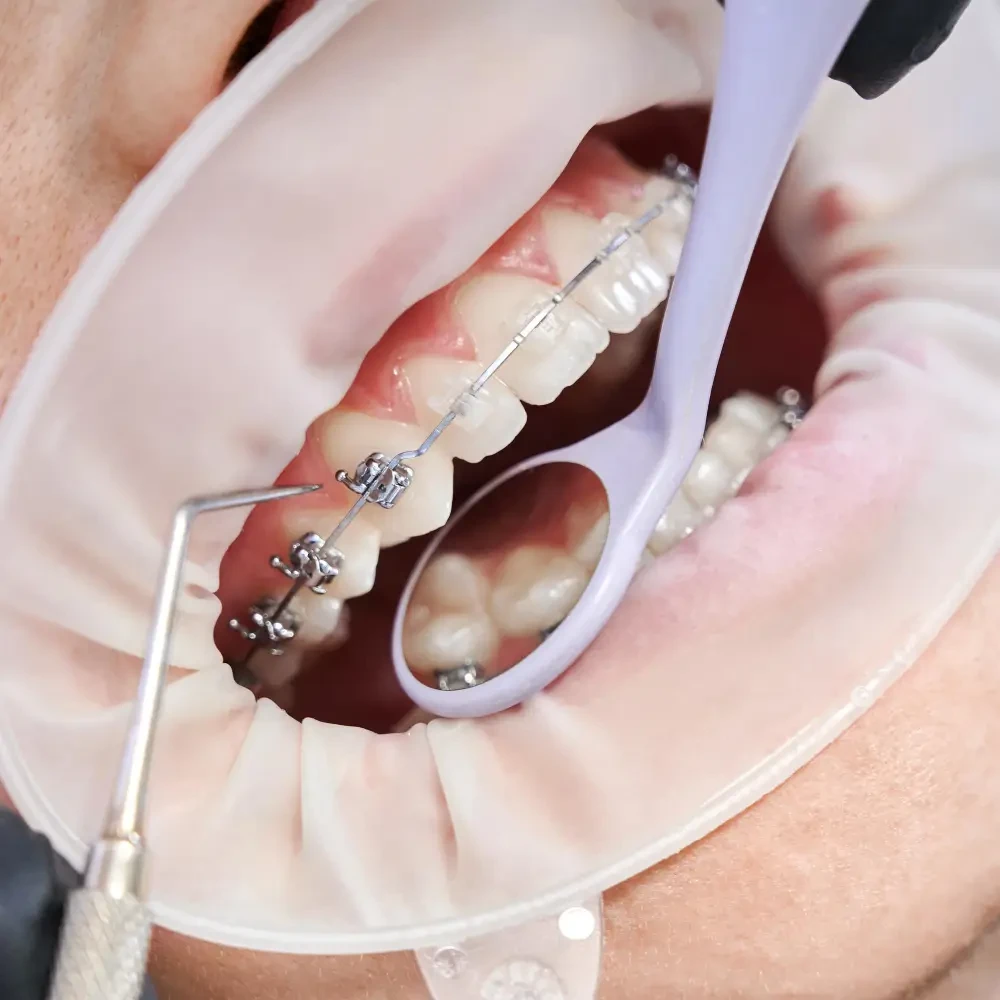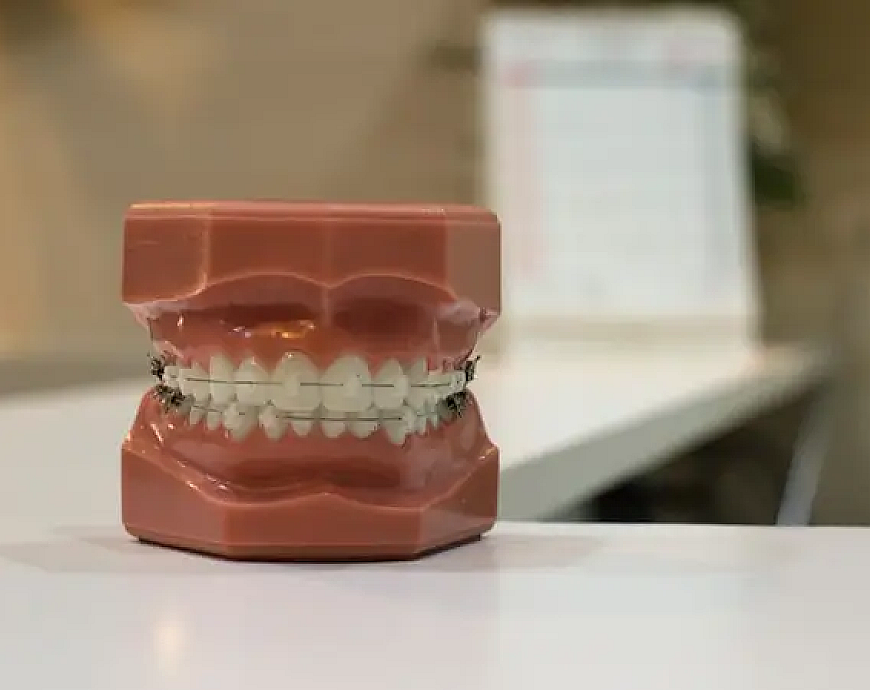Safety and quality
Painless dental treatments
Dental treatments with payment in installments
A dental clinic, all specialties
Sapphire braces represent a device used in orthodontic treatments to correct teeth positioning problems on the dental arches or in the alveolus. Although more expensive than traditional treatment, sapphire braces provide major aesthetic and functional benefits. Patients who opt for sapphire braces treatment are, in most cases, young adults and teenagers.
What are a sapphire braces?
Sapphire braces are a type of fixed orthodontic braces made of brackets made of synthetic sapphire, an extremely hard and transparent material, biocompatible and non-allergic. Just like traditional metal braces, the sapphire braces are bonded to the front surface of each tooth and connected by metal or elastic springs.
When are sapphire braces recommended?
The sapphire orthodontic braces are recommended for patients who need dental corrections but want, at the same time, to maintain a natural and discreet appearance during treatment. Braces are recommended to be used around the age of 11-14 years, when the growth of the jawbones is still in progress and the movement of the teeth is easier to control.
Compared to other options, the sapphire brace is preferred for its transparency, but also for the increased comfort provided by the smooth edges of the brackets. Although effective for a wide range of orthodontic problems, there are specific situations where a sapphire brace is not the most appropriate option. For example, sapphire braces may not be an option for very complex, intensive dental problems, or for patients who play contact sports and are at risk of accidents.
To determine whether sapphire braces are the right solution for your case, an initial consultation with an orthodontist is recommended. In this sense, appointments at the Dentarbre clinic can be made by accessing the appointments page or by phone.
Until what age can you wear sapphire braces?
Sapphire braces can be used by people of all ages, including adults. There is no specific upper age limit for wearing it, and orthodontic treatments can be successfully performed even at advanced ages.

Sapphire braces: Advantages and Disadvantages
Sapphire braces have a number of specific advantages and disadvantages. In general, the advantages include the transparency of the brackets and their superior compatibility with oral tissues, while the disadvantages include the higher cost compared to other options.
The advantages of sapphire braces
The main advantage of the sapphire dental braces is represented precisely by its aesthetics, superior to other models of fixed dental appliances. Sapphire brackets are transparent, a major benefit for patients who emphasize aesthetics during treatment. In addition, sapphire braces are stain-resistant, maintaining their appearance throughout treatment, regardless of food or drink consumed.
Another advantage is comfort. The sapphire brackets are smooth and well finished, which reduces the risk of irritation of the soft tissues in the oral cavity. Also, the material from which they are made is very durable, being resistant to cracks and fractures, which ensures a longer lifespan of the device.
Disadvantages of sapphire braces
Compared to other types of braces, sapphire braces are more expensive, which can be a barrier for some patients. In addition, although the transparency is an aesthetic advantage, at the same time, the very transparency of the material can make it more difficult to detect possible bacterial plaque accumulations.
How much does a sapphire braces cost?
The final cost of orthodontic treatment is influenced by the complexity of the case, the duration of the treatment, as well as the experience of the doctor. The price may increase if it is necessary to carry out additional treatments or procedures, as well as if the number of controls required to adjust the device is higher than anticipated. Consequently, including patient involvement and how the body responds to treatment can influence the final cost.
Sapphire dental braces price
| Procedure | Cost (in RON) |
| Orthodontic consultation + Orthodontic treatment plan | 200 |
| Study model | 100 |
| Sapphire Dental braces / arch | 3500 |
| Dental braces control per arch | 100 |
| Dental braces control - both arches | 200 |
| Replace Sapphire bracket | 200 |
| Fix bracket | 100 |
| Change arch | 50 |
| Elastics | 20 |
| Remove dental braces | 200 |
| Fixed retainer | 350 |
| Gutter-type containment (mouth guard) | 400 |
For up-to-date pricing details, please refer to the clinic's rates page. You can access the clinic rates using the DentArbre dental services prices link.

Stages of treatment with sapphire braces
Orthodontic treatment with sapphire braces involves, to begin with, a consultation with an orthodontist, in order to identify occlusion problems and the most suitable treatment options. During the first appointment with the orthodontist, it is determined, based on the clinical examination and the results of the imaging examinations, whether the sapphire braces are suitable for the patient's needs.
Before braces are fitted, teeth must be professionally cleaned to remove plaque and tartar. Preliminary treatments, such as fissure sealing or cavity treatment, may also be necessary to ensure a healthy base for the brackets.
The next stage of the treatment involves applying the sapphire brackets to each individual tooth, using a special dental adhesive. The brackets are then connected by a metal spring that will put pressure on the teeth. The procedure is painless and takes between one and two hours. After the braces are applied, the patient can go home, returning to the doctor at regular intervals (usually every 4-8 weeks) to adjust the braces.
Once the treatment has been completed and the teeth have reached the desired position, the braces are carefully removed. As with the application of brackets, the procedure for their removal is quick and painless. After removing the brackets, the teeth are cleaned of any adhesive residue.
After the appliance is removed, the patient will receive a retainer, which they will wear as directed by the doctor, to keep the teeth in their new position. The retention phase, necessary to prevent relapse and to stabilize the results obtained, generally lasts between 6 and 12 months.
Sapphire braces vs. ceramic - What's the difference?
Sapphire and ceramic braces are the favorite options of patients who want an aesthetic and discreet orthodontic solution. The main difference between the two types of appliances lies in the material from which the brackets are made. Sapphire braces use clear sapphire crystals, while ceramic braces are made of an opaque, tooth-colored material that is almost as transparent as sapphire.
Sapphire braces vs. metalic
There are significantly more differences between sapphire vs. metal braces than sapphire vs. ceramic. In addition to the material the brackets are made of, which is also different, there are also major differences in terms of aesthetics and cost. Metal braces are known for their high efficiency and durability and are often used for complex orthodontic cases. However, its brackets are very visible, which can be an inconvenience for patients who want a discreet solution. On the other hand, metal braces are more affordable than sapphire braces and are more resistant to possible damage.
How to care for your sapphire braces
To maintain a transparent sapphire brace in optimal condition and to ensure the effectiveness of orthodontic treatment, the following is recommended:
- maintaining good oral hygiene;
- avoiding hard and sticky foods;
- cleaning the dental appliance with special solutions or with warm water;
- monitoring the progress of the treatment, by participating in regular controls;
- the use of a protective device during contact sports.

Dr. Laura Roșca answers questions:
+40787877799 | +40762573398
contact@dentarbre.comȘoseaua Colentina, nr. 16, Bl. A1, Complex Rose Garden, Sector 2, Zona Obor - Colentina - Doamna Ghica
